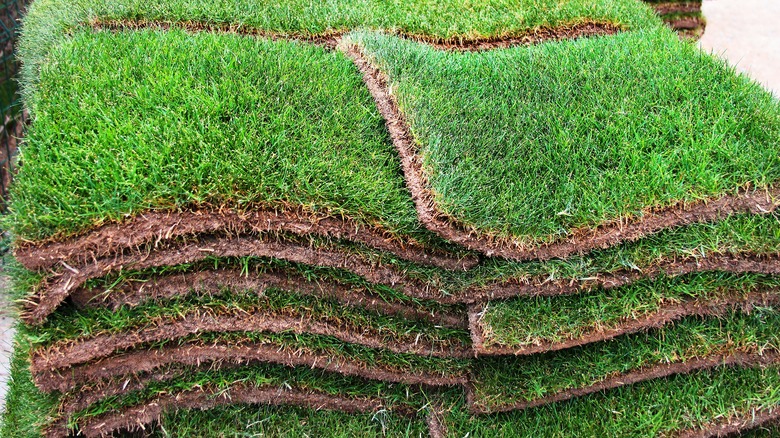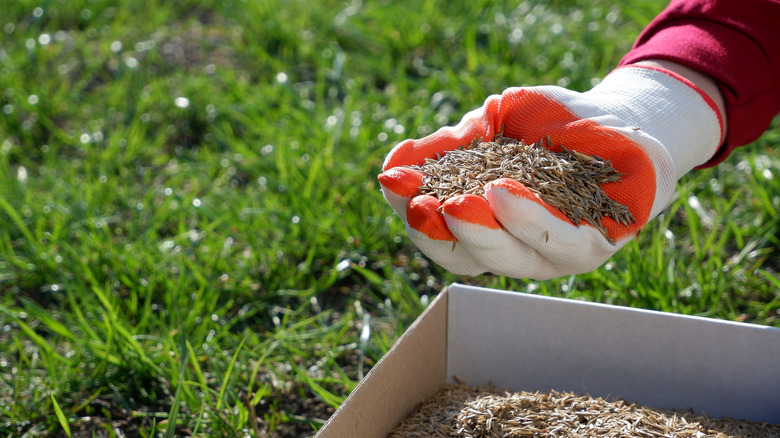Do DIY Sod Patching Kits Actually Work? Here's What Our Expert Says
We may receive a commission on purchases made from links.
When your yard starts to have areas with dead grass, it can make your outdoor space less aesthetically pleasing, so you may look for a simple solution for filling in those patchy spots in your lawn. While do-it-yourself sod patching kits like Scotts EZseed patch and repair mulch (about $62 on Amazon) may seem like the best or easiest option, our expert explained the pros and cons of both using a patching kit versus laying new sod. Bryan Clayton, CEO of GreenPal, a lawn care booking company, told House Digest exclusively that these DIY kits can be capable of filling patches, but they may not be as simple as they seem. "These kits can work, but they're no replacement for actual sod," Clayton said. "Scotts EZSeed and similar kits are okay, but they're dependent on good soil prep." While these seed kits can help your lawn, there's more to do than just dump the bag over your patchy grass.
Depending on your needs and your budget, a DIY sod patching kit could be perfect for you, or you might choose to invest in some new sod; however, it can sometimes be difficult to find small amounts of sod, according to Clayton. If you plan to use a DIY patching kit for your lawn, you'll need to ensure you're doing it correctly for it to work well.
The best way to patch your lawn
While patching kits can come in handy, Bryan Clayton explained to House Digest exclusively that laying some new sod is the best way to repair patches on your lawn. "If you want quick, reliable results, sod is the best option," Clayton said "If you can get your hands on a few pieces, sod is the quickest way to fill in bare spots." While sod can be a better option in a lot of cases, our expert explained that there are some downsides to this method as well. For example, putting down sod during the end of summer, when temperatures are high and the sun is brutal, will just kill it.
Additionally, Clayton explained that purchasing new sod can often be expensive, as you may have to buy more than you actually need. "The problem with sod is that you often need to buy a whole pallet, which can get expensive. Home Depot sells individual squares, but usually only around spring," he said. If you decide to lay new sod rather than use a patching kit, Clayton recommends watering it multiple times a day for the first several weeks it's growing. For those that can't get their hands on only a piece or two of sod or if it's too hot outside, a patching kit could be better for you, as long as you prepare the soil properly.
Using DIY sod patching kits
If patching your lawn with new sod is too expensive or not a viable option, our expert has some tips for repairing the thinning grass in your yard with the DIY kits. Bryan Clayton told House Digest exclusively that good soil preparation is the key to making these kits actually work, in conjunction with proper watering. "You can't just spread the patch mix over hard soil and expect it to work — it's like throwing seed on concrete," he said. "You need to agitate the soil to give the seed some room to take root." Before spreading your seeds over patchy areas of your lawn, get rid of the dead grass and dig up the dirt a bit to help the new seeds get into the soil.
Besides making sure the soil is able to foster new growth, you'll also need to consistently water the grass seeds, similarly to placing sod. Clayton recommends watering spots where you've spread the patching seeds approximately twice a day for several weeks. "If you can't do sod, then these patch kits are a decent backup, but be ready to put in the work prepping the soil and keeping it watered," he said. While our expert recommends sod as the best and fastest option, it isn't accessible to everyone, so following these tips for DIY patching kits will help ensure they actually work.


